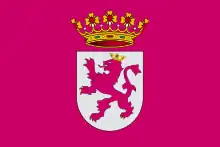 | |
| Total population | |
|---|---|
| 969,783 leoneses in Leonese Region | |
| Regions with significant populations | |
| Languages | |
| Majority: Spanish Minority: Leonese • Galician | |
| Religion | |
| Roman Catholicism[1] | |
| Related ethnic groups | |
| other Spaniards (Asturians, Cantabrians, Vaqueiros de alzada, Extremadurans, Galicians, Castilians), Mirandese |
| Part of a series on the |
| Spanish people |
|---|
_alternate_colours.svg.png.webp) Rojigualda (historical Spanish flag) |
| Regional groups |
Other groups
|
| Significant Spanish diaspora |
| Languages |
|
Other languages |
|
|
The Leonese (Leonese: Llïoneses; Spanish: Leoneses) are a subgroup of Spaniards, native to León in Spain.
The Leonese Kingdom was an independent kingdom in the Middle Ages until 1230 when it was joined to the Kingdom of Castile (from 1296 to 1301 the Kingdom of León was again independent); after the re-union with Castile in 1301 it remained a kingdom until 1833, but as part of a united Spain from 1479. In 1833 it was divided into three provinces. The languages of the Leonese people are Leonese, Galician and Castilian Spanish in Spain.
Geography and demographics
Political and administrative divisions
The former Kingdom of León was divided into three historical regions: Asturias, León, and Extremadura, with the eastern territories into Castile. The Spanish division of 1833[2] recognised as Leonese the provinces of León, Salamanca, and Zamora. They are now part of Castile and León.
Leonese language
The Leonese language (Llingua Llïonesa in Leonese) developed from Vulgar Latin.
Leonese was the official language of the Leonese Kingdom in the Middle Ages. The first written text in Leonese was Nodicia de Kesos (959 or 974), and other old texts include Fueru de Llión, Fueru de Salamanca, Fueru Xulgu, Códice d'Alfonsu XI, Disputa d'Elena y María, and Llibru d'Alixandre[3]
Its precarious situation as a minority language has driven Leonese to near extinction; it is considered a seriously endangered language by UNESCO.[4]
Leonese cuisine
Embutidos
- Cecina from León: from beef. In Leonese, cecina means "meat that has been salted and dried by means of air, sun or smoke". Cecina de León is made of the hind legs of beef, salted, smoked and air-dried in the province of León in Northwestern Spain, and has PGI status.
- Botillo: from pork. Traditionally made in the western Leonese regions. Botiellu, in Leonese language, is a dish of meat-stuffed pork intestine. It is a culinary specialty of El Bierzo, a county in the Spanish province of León and the region of Trás-os-Montes in Portugal where it is known as Botelo. This type of Embutido (Spanish) ou Enchido (Portuguese) is a meat product made from different pieces left over from the butchering of a pig, including the ribs, tail, and bones with a little meat left on them. These are chopped; seasoned with salt, pepper, garlic, and other spices; stuffed in the cecum of the pig; and partly cured via smoking. It can also include the pig's tongue, shoulder blade, jaw, and backbone, but may never exceed 20% of the total volume. It is normally consumed cooked and covered with a sheet. Also has a PGI status.
- Farinato
Wines
- Bierzo: is in the west of the Province of León and covers about 3,000 km2 (1,200 sq mi). The area consists of numerous small valleys in the mountainous part (Alto Bierzo) and of a wide, flat plain (Bajo Bierzo). The DO covers 23 municipalities.
- Tierras de León: is in the southeast of the Province of León.
- Toro: is in the east of the Province of Zamora.
- Arribes: is in the southeast of the Province of Zamora and the northwest of the Province of Salamanca. There are 750 ha of vineyards registered with the Consejo Regulador (Governing Body)
Sweets
- Mantecadas de Astorga
- Hojaldres de Astorga
- Lazos de San Guillermo
- Nicanores de Boñar
Religion
The majority of Leonese are Roman Catholic.
TLD Campaign
PuntuLLI Association[5] fights for a Top Level Domain for the Leonese language and culture.
See also
References
- ↑ Interactivo: Creencias y prácticas religiosas en España
- ↑ Real Decreto de 30 de noviembre de 1833
- ↑ Menéndez Pidal, R. "El Dialecto Leonés". Madrid. 1906
- ↑ UNESCO Red Book on Endangered Languages: Europe
- ↑ listed by cityTLD as a Top Level Domain initiative
External links
- https://web.archive.org/web/20090318174242/http://www.puntulli.org/ Top Level Domain for Leonese language
- http://www.elfueyu.net/ Leonese language Association
- https://archive.today/20120730/http://www.eltoralin.com/ Leonese language Association from El Bierzo
- http://www.aytoleon.es/ Leonese City Council
- http://www.dipuleon.es/ Leonese Provincial Council